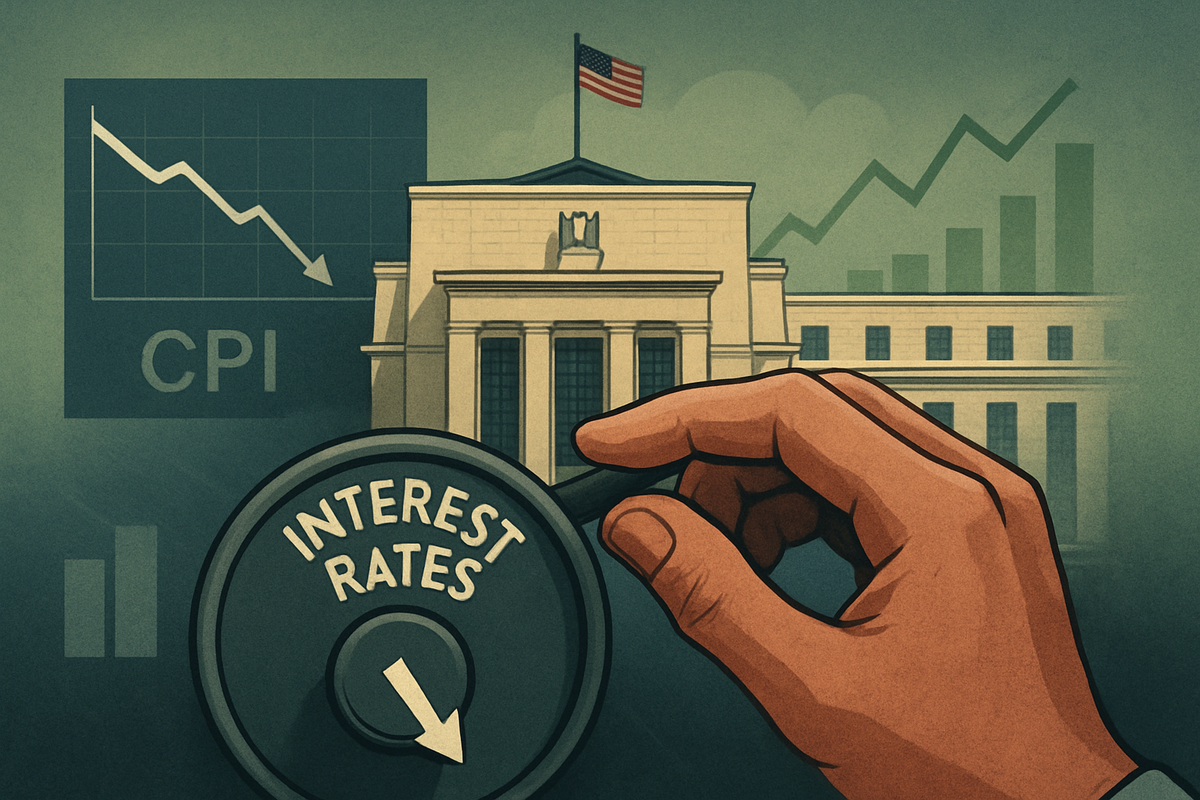
Washington D.C., October 24, 2025 – Financial markets are buzzing with anticipation today as the Federal Reserve prepares for its crucial meeting next week, October 28-29. The overwhelming sentiment points towards an imminent interest rate cut, a move heavily influenced by the recently released Consumer Price Index (CPI) data for September 2025. This cooler-than-expected inflation report has effectively given the central bank a green light to prioritize concerns over a softening labor market, signaling a potential shift towards a more accommodative monetary policy.
Investors are now pricing in a near-certainty of a 25 basis point reduction in the federal funds rate, which would mark the second consecutive cut in as many months. This aggressive stance by the Fed aims to preempt further economic deceleration, particularly in the employment sector, which has shown signs of weakening. The market's reaction has been largely positive, with equity indices rallying and bond yields declining, as participants hope that cheaper borrowing costs will bolster economic activity and corporate earnings.
The Dovish Turn: CPI Data Paves the Way for Easing
The stage for the Fed's dovish pivot was set by the September 2025 CPI report, released today, October 24, 2025. This critical economic indicator, which saw a slight delay due to an ongoing government shutdown, revealed a headline CPI year-over-year increase of 3.0%, modestly below the anticipated 3.1%. More significantly, the core CPI, which strips out volatile food and energy prices, registered a decline to 3.0% from 3.1% in August, also undershooting market expectations. These figures, while still above the Fed's long-term 2% target, have assuaged fears of accelerating inflation, providing the Federal Open Market Committee (FOMC) with greater flexibility.
The timeline of events leading to this moment has been marked by increasing economic uncertainty. The Fed initiated its first rate cut in September 2025, a "risk management cut" designed to mitigate growing downside risks to employment. This was preceded by several months of slowing job growth and other indicators suggesting a cooling economy. The September CPI data, therefore, arrived at a pivotal time, allowing policymakers to justify further easing without being perceived as abandoning their inflation-fighting mandate. Key players in this unfolding narrative include Federal Reserve Chair Jerome Powell and the broader FOMC, whose public statements and minutes have consistently hinted at a data-dependent approach. Economists and market strategists from institutions like JPMorgan Chase (NYSE: JPM) and Goldman Sachs (NYSE: GS) have largely aligned with the view that rate cuts are necessary to sustain economic growth.
Initial market reactions have been swift and decisive. U.S. stock markets, including the S&P 500 (INDEXSP: .INX), surged to new all-time highs, reflecting investor optimism for a lower interest rate environment. The yield on the benchmark 10-year Treasury note dipped below 4%, indicating a flight to safety and a belief that long-term rates will trend lower. The U.S. dollar weakened against a basket of major currencies, a typical response to anticipated rate cuts. Furthermore, the ongoing partial government shutdown, while complicating data releases, is also seen by some as an additional drag on economic activity, further strengthening the case for monetary stimulus.
Winners and Losers: Navigating the Rate Cut Landscape
A shift towards lower interest rates fundamentally alters the financial calculus for various sectors and public companies, creating distinct winners and losers. Generally, growth-oriented companies and those with significant debt burdens tend to benefit most, as borrowing costs decrease and the present value of future earnings rises. Conversely, some sectors, while not necessarily "losing," may see their relative attractiveness diminish or face margin pressures.
The technology sector stands out as a primary beneficiary. Companies like Apple Inc. (NASDAQ: AAPL), Microsoft Corp. (NASDAQ: MSFT), and Amazon.com Inc. (NASDAQ: AMZN), often characterized by high growth potential and reliance on capital for expansion, will find it cheaper to finance innovation, research and development, and strategic acquisitions. Similarly, fintech innovators such as Block Inc. (NYSE: SQ) could see improved margins on credit products and increased consumer spending. The reduced cost of capital also boosts their valuations, as future cash flows are discounted at a lower rate, making their stock more appealing to investors.
The housing and real estate sectors are also poised for a significant uplift. Lower interest rates directly translate to more affordable mortgage rates, stimulating demand from homebuyers. This bodes well for homebuilders like D.R. Horton, Inc. (NYSE: DHI) and Lennar Corporation (NYSE: LEN), who can expect increased sales volumes and improved margins on new constructions. Real Estate Investment Trusts (REITs) such as Simon Property Group (NYSE: SPG) will benefit from lower financing costs for property acquisitions and development, potentially leading to higher dividend payouts and capital appreciation. Companies like Zillow Group, Inc. (NASDAQ: Z) could see increased revenue from higher real estate transaction volumes.
Conversely, the impact on the financial sector, particularly traditional banks, can be mixed. While lower rates can stimulate loan demand and capital market activities, they also tend to compress net interest margins (NIMs)—the difference between what banks earn on loans and pay on deposits. This could put pressure on profitability for institutions like Capital One Financial Corp. (NYSE: COF) and regional banks such as First Horizon Corporation (NYSE: FHN), even as investment banks like Goldman Sachs Group, Inc. (NYSE: GS) might see a boost from increased underwriting and advisory activity. Consumer staples companies like Procter & Gamble Co. (NYSE: PG) and Walmart Inc. (NYSE: WMT), typically seen as defensive plays, may experience relative underperformance as investors rotate into higher-growth sectors in a more accommodating economic environment.
Broader Implications: A Balancing Act for the Economy
The Federal Reserve's anticipated rate cut extends far beyond immediate market reactions, signaling a significant shift in monetary policy and carrying wider implications for the economy, industries, and global finance. This dovish pivot, prioritizing a weakening labor market over persistent but "cooler-than-expected" inflation, underscores the Fed's delicate balancing act under its dual mandate.
In terms of broader industry trends, the rate cuts are expected to provide a tailwind for capital-intensive sectors. The housing and real estate markets, for instance, are likely to see sustained momentum as lower mortgage rates make homeownership more accessible and construction projects more viable. The technology sector will benefit from reduced borrowing costs for innovation and expansion, potentially accelerating growth in areas like artificial intelligence and cloud computing. Conversely, the financial sector, particularly traditional banks, may face continued pressure on net interest margins, even as increased loan demand could offer some offset. Consumer spending, buoyed by cheaper credit, is also expected to receive a boost, impacting retail and consumer discretionary industries.
The ripple effects of a U.S. rate cut extend globally. A weaker U.S. dollar, a common outcome of monetary easing, could make American exports more competitive on the international stage, benefiting multinational corporations. It could also alleviate debt burdens for emerging markets with dollar-denominated obligations, potentially leading to increased capital inflows into these economies. Competitors and partners across various industries might find it easier to secure financing for joint ventures or expansion, fostering a more dynamic global investment environment.
Regulatory and policy implications are also significant. The anticipated rate cut, coupled with expectations of an end to quantitative tightening (balance sheet runoff), marks a clear strategic shift by the Fed to inject liquidity and support economic growth. This move is particularly challenging given the ongoing government shutdown, which has created an "informational vacuum" by delaying crucial economic data. The Fed is thus forced to make decisions based on potentially incomplete information, relying heavily on its own economic assessments and fragmented indicators. Historically, the Fed often cuts rates in response to economic slowdowns, and while not all cutting cycles lead to a recession, the current environment presents a unique test of the central bank's ability to navigate an economy grappling with both stubborn inflation and labor market fragility.
The Road Ahead: Navigating a Shifting Economic Landscape
The anticipated Federal Reserve interest rate cut in October 2025 marks a pivotal moment, setting the stage for a period of strategic adjustments for businesses, investors, and policymakers alike. In the short term, markets are already pricing in further easing, with many analysts expecting at least one more rate cut by year-end, potentially bringing the federal funds rate to its lowest point since late 2022. This aggressive easing cycle is primarily aimed at buttressing a softening labor market and preventing a more significant economic downturn.
For businesses, the immediate future presents opportunities for strategic pivots. Companies with substantial debt loads should prioritize refinancing at lower rates to improve cash flow and profitability. Sectors poised for growth, such as technology, housing, and consumer discretionary, may accelerate expansion plans, invest in new projects, and increase hiring, leveraging cheaper capital. However, financial institutions will need to adapt to potentially compressed net interest margins, perhaps by focusing on fee-based services and operational efficiencies. Long-term, projections suggest a continued, albeit slower, pace of rate cuts into 2026 and even 2027, aiming to guide the federal funds rate towards a more normalized range.
Investors face a dynamic environment with both opportunities and challenges. A shift from high cash allocations to bonds, particularly short-to-intermediate duration and selective credit, may prove beneficial as cash yields decline. Equities, especially U.S. large-cap growth stocks, are expected to remain attractive. The weakening U.S. dollar could also create opportunities in foreign equities, bonds, and commodities. However, savers will contend with lower returns on fixed-income investments, and market volatility is likely to persist, particularly if inflation proves more stubborn or if further government shutdowns disrupt economic data releases. Policymakers, on their part, will remain highly data-dependent, with CPI and labor market reports continuing to be critical inputs for future decisions, as they strive to balance the dual mandate of full employment and price stability.
Market Minute Wrap-Up: A New Chapter for Monetary Policy
The Federal Reserve's anticipated interest rate cut in October 2025, heavily influenced by cooler-than-expected CPI data and growing concerns over the labor market, signifies a crucial inflection point in monetary policy. The central bank is clearly prioritizing economic stimulus and employment stability, even as inflation remains modestly above its long-term target. This strategic shift has already ignited a positive response in equity markets and driven down bond yields, as investors embrace the prospect of cheaper capital and an extended period of accommodative policy.
Key takeaways from this evolving scenario include the enhanced attractiveness of growth-oriented sectors like technology and real estate, the potential for increased consumer spending, and the need for financial institutions to adapt to narrower profit margins. Globally, a weaker dollar could reshape trade dynamics and capital flows. While the Fed's proactive stance aims to avert a deeper economic slowdown, the path ahead is not without its challenges, particularly given lingering inflation risks and the complexities introduced by government shutdowns affecting data availability.
Moving forward, investors should closely monitor upcoming economic data, especially subsequent CPI and employment reports, for any signs of inflation re-acceleration or further labor market deterioration. The Fed's communication will be paramount in guiding market expectations, and any divergence from the anticipated easing trajectory could introduce significant volatility. The current environment calls for a nuanced investment strategy, emphasizing diversification and a keen eye on sectors poised to benefit from lower borrowing costs, as the U.S. economy embarks on a new chapter of monetary policy.
This content is intended for informational purposes only and is not financial advice






